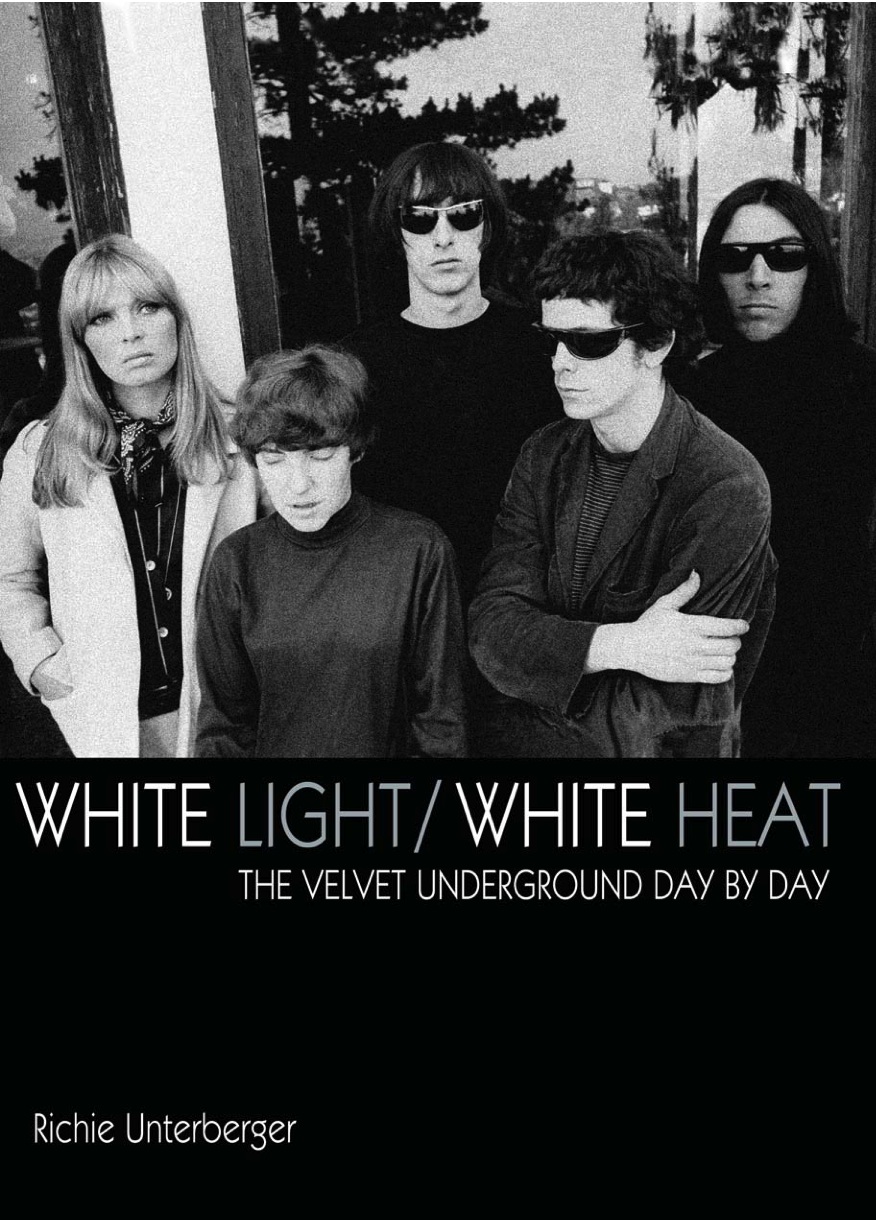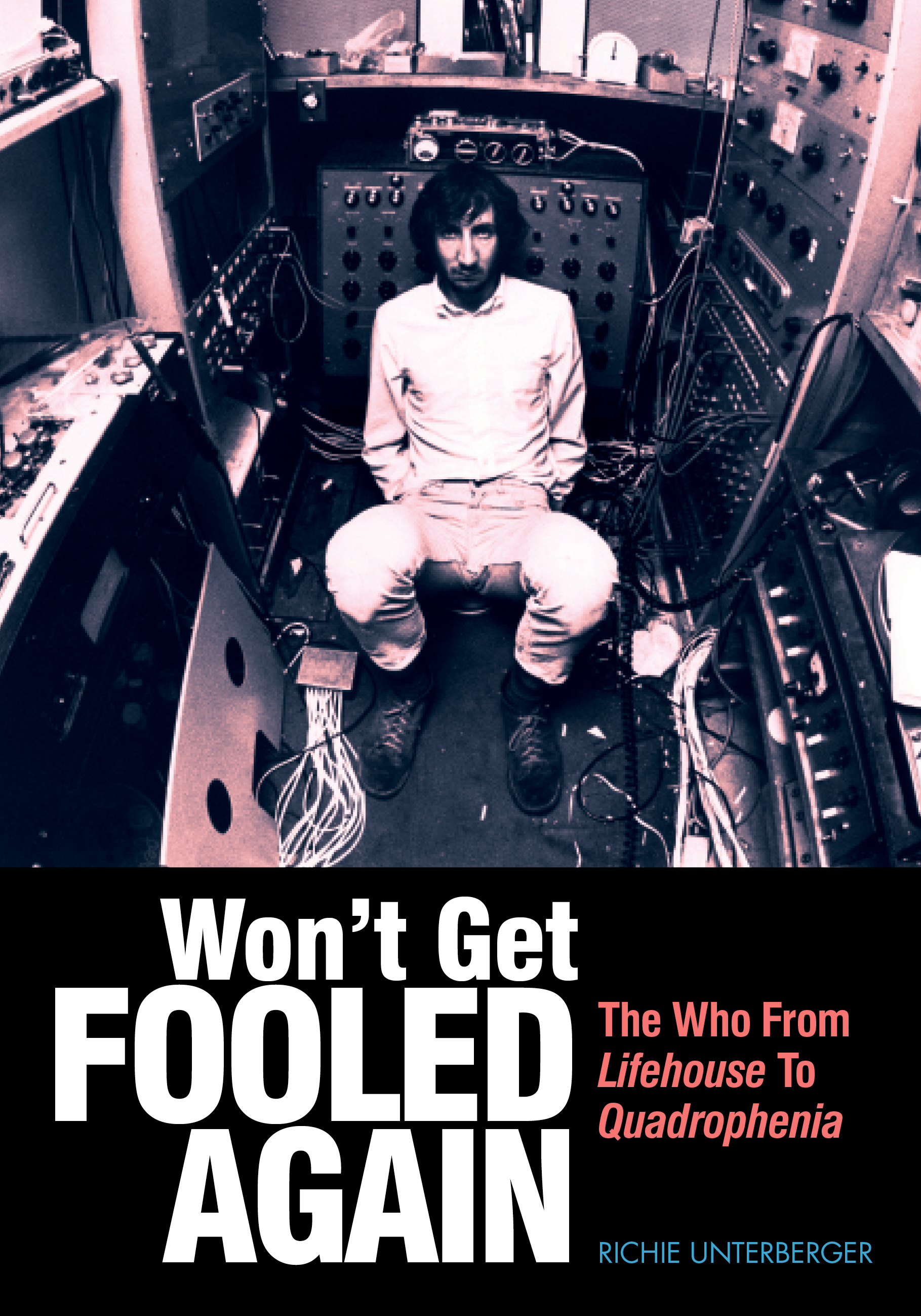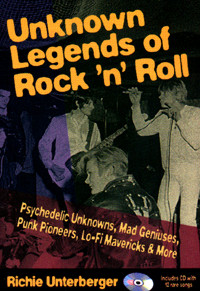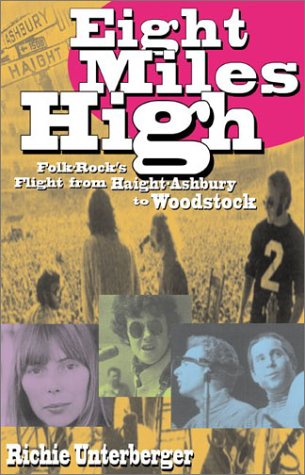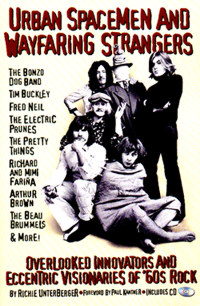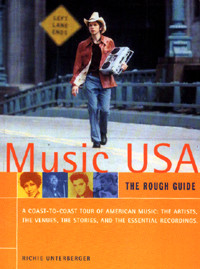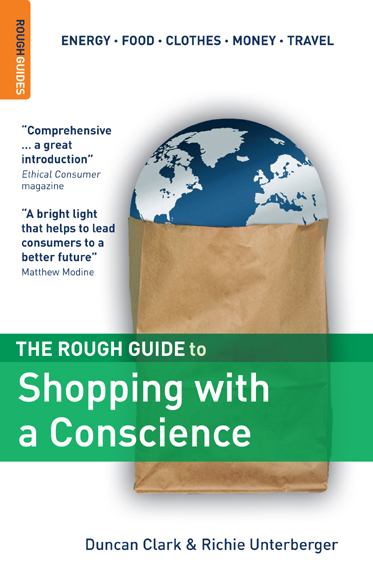 |
 |
 |
 |
 |
 |
 |
 |
 |
 |
Out now: My book Won't Get Fooled
Again: The Who from Lifehouse to Quadrophenia details the
Who's amazing and peculiar journey in the years during which they
struggled to follow up Tommy with
a yet bigger and better rock opera. One of those projects, Lifehouse, was never completed,
though many of its songs formed the bulk of their 1971 album Who's Next. The other, Quadrophenia, was as down-to-earth
as the multimedia Lifehouse was
futuristic; issued as a double album in 1973, it eventually became
esteemed as one of the Who's finest achievements, despite unavoidable
initial unfavorable comparisons to Tommy.
Drawing on material from several dozen interviews and mountains of rare
archival coverage and recordings, it's the definitive account of this
fascinating period in the Who's career, which saw both some of their
greatest triumphs and, in Lifehouse,
rock's most spectacular failure. Notes MOJO's four-star review of the
book, "Unterberger digs deep and deeper still through obscure press
cuttings and his own interviews with engineers, producers and fans to
make sense of it all. He does a grand job."
I wrote all of the historical essays and
picture captions for the new Taschen book San Francisco: Portrait of a City,
which tells the history of San Francisco with several hundred photos
from 1850 through the present. I also did some of the photo research
for the book, which was published in March 2022.
Also out: My
2009
book, White
Light/White Heat: The
Velvet Underground Day-By-Day (now available on Jawbone
Press), is by far the most comprehensive book on the Velvet Underground
ever published. The 368-page volume details the group's recording
sessions, record releases, concerts, press reviews, and other major
events shaping their career with both thorough detail and critical
insight. Drawing on about 100 interviews and exhaustive research
through documents and recordings rarely or never accessed, it unearths
stories that have seldom been told, and eyewitness accounts that have
seldom seen print, from figures ranging from band members to managers,
producers, record executives, journalists, concert promoters, and fans.
The July 2009 issue of MOJO magazine
hails it as "an impressive means to reflect on the conundrum of what
could be the ultimate cult band...detailed and anecdote-packed"; Uncut magazine chose it as #4 in
its list of the ten best music books of 2009.
White Light/White
Heat:
The Velvet
Underground Day-By-Day includes not only basic
nuts-and-bolts
facts, but also many behind-the-scenes stories as to how their songs
were written and recorded; how their strikingly original stage shows
were devised; how the band were perceived by reviewers at the time of
their 1965-70 heyday, not just in retrospect; and how the group as a
whole underwent a most improbable, incessantly unpredictable evolution
from the most avant-garde of bohemian origins into a highly accessible,
yet still boldly creative, rock band by the time Lou Reed left the
group he'd co-founded with John Cale in early 1965. Along
the way, many unreleased concert and studio
recordings are vividly described; many obscure and unlikely concerts
delineated; and many myths that have grown up around this most
legendary of all cult bands untangled and dissected.
White
Light/White Heat: The Velvet Underground Day-By-Day also
features more than 100 illustrations, including reproductions of rarely
or never seen photos, concert posters, letters, and other
assorted documents and memorabilia. It's the ultimate history of the
band that did more than any other to break down barriers between rock
music and the avant-garde, incorporating electronic innovations,
experimental instrumentation and improvisation, and lyrics detailing
the realities of sex, drugs, and rock'n'roll with greater skill and
daring than anyone else. Also available in French as White
Light/White Heat: Le Velvet Underground Au Jour Le Jour (on
Le Mot Et Le Reste) and in Czech as White
Light/White Heat: Velvet Underground Den Po Dni (on Volvox
Globator). The updated/expanded ebook version, available on Amazon
and iTunes,
adds more than 40,000 words of additional material.
Also, I wrote the 13,000-word liner notes to
the six-CD
super-deluxe edition of The Velvet
Underground & Nico, released in October 2012.
On Wednesday, January 7 from 6pm-7:30pm in the Koret Auditorium of the Main branch of the San Francisco Public Library at 100 Larkin Street in the Civic Center, I'm doing a program on early San Francisco punk and new wave. Focusing on the mid-1970s through the ealry 1980s, the Avengers, Crime, the Residents, the Mutants, the Sleepers, Flipper, and Romeo Void will be among the acts represented by film clips and discussion. Admission is free. This is an in-person program, and will not be on Zoom or recorded. Basic event details are at https://sfpl.org/events/2026/01/07/presentation-early-san-francisco-punk-new-wave.
On Monday, January 12 from 1pm-2:30pm at the Jewish Community Center of San Francisco at 3200 California Street, I'll present Motown Records: The Greatest Soul Music Label at the Jewish Community Center of San Francisco at 3200 California Street. I'll show and discuss performance clips from the label's prime in the 1960s and early 1970s by stars like the Supremes, the Temptations, the Miracles, Mary Wells, Martha & the Vandellas, the Four Tops, Stevie Wonder, Gladys Knight, Marvin Gaye, and the Jackson Five. Admission is free, though registration is advised through https://www.jccsf.org/event/motown-records-the-greatest-soul-music-label/. This event will not be on Zoom or recorded.
Blog: I've started a blog where I post about various topics, including vintage rock music, biking and hiking in the San Francisco Bay Area, socially responsible living, and baseball. Go to Folkrocks to check it out.
I've also written numerous rock history articles for the PleaseKillMe.com website since mid-2018, including stories on Van Morrison's August 1968 live Boston tape, briefly released in late 2018 on iTunes; the expanded DVD version of the Sympathy for the Devil film, including interview material from cinematographer Tony Richmond; a lengthy interview with the Velvet Underground's Doug Yule; an interview with Yardbirds drummer Jim McCarty about his recent memoir; an overview of Joe Boyd's Witchseason production company, responsible for the production/management of top British folk-rockers Fairport Convention, Nick Drake, the Incredible String Band, and others, including interview material with Boyd and several Witchseason artists; an interview with producer John Simon (the Band, Big Brother & the Holding Company) about his recent memoir; an overview of the recent eight-CD Dutch Nuggets box set of 1960s Dutch rock, including an interview with the set's annotator, Ugly Things magazine editor/publisher Mike Stax; recently excavated 1967 recordings by Gene Clark; a long interview with the Lovin' Spoonful's Steve Boone; the reissue compilation of Bob Seger's mid-1960s singles; an interview with Student Teachers drummer Laura Davis-Chanin about her memoir; late-'60s David Bowie demos released for the first time fifty years later; and God's Children, the early 1970s Latino soul-rock-pop band with former Thee Midniters singer Willie Garcia.
In Ugly Things: Issue #49 (Winter 2018)
of the (mostly) 1960s
rock-centered magazine Ugly Things has my lengthy
interviews with original Manfred Mann singer Paul Jones and Manfred
Mann bassist/guitarist Tom McGuinness. Issue
#44 (Spring 2017) has my similarly lengthy
interview with Dean Torrence of Jan & Dean. Issue
#42 (Summer 2016) has my longinterview with
original Yardbirds bassist
(and, through mid-1966, musical director) Paul Samwell-Smith. Issue #38
(Fall/Winter
2014) has my 16-page interview with Kinks
guitarist Dave Davies. The article also
includes an extensive sidebar of information about the Kinks' 1960s
career that I unearthed on my visit to the Rock and Roll Hall of Fame
Library and Archives in spring 2014.
Also in Ugly Things, issue #31 (Spring 2011) and issue #32 (Fall/Winter 2011) have my mammoth (30,000-word) two-part interview with Billy Harrison, guitarist for the great mid-1960s band Them, Van Morrison's first group. Issue #25 has my huge (30-page) story on the Music Machine, one of the greatest garage-psychedelic groups of the 1960s, and the group that had more depth and quality to their original repertoire than perhaps any other '60s band who are known primarily for one hit single ("Talk Talk," in the Music Machine's case). The article is based around lengthy interviews with two original members (bassist Keith Olsen and guitarist Mark Landon) who have rarely spoken about their experiences in the group, as well as two members of the second Music Machine lineup (keyboardist Harry Garfield and guitarist Alan Wisdom) who have never before discussed their stint in the band.
Issue #23 (Summer
2005) has
my similarly lengthy (20-page) story on the Belfast Gypsies. Including
ex-members of
Them, they were one of the finest overlooked bands of the British
Invasion,
their sole 1966 album produced by the legendary Kim Fowley. This is the
first comprehensive history of this mysterious group ever to appear,
the
twisted stranger-than-fiction saga drawn from extensive interviews with
Belfast Gypsies guitarist Ken McLeod, who consulted his original
diaries
from the mid-'60s to reconstruct the group's career. Excerpts from my
interview
with Kim Fowley about the Belfast Gypsies also appear in the article;
for
the full interview, click here.
In Record Collector: The April and May
2013 issues of the British monthly magazine Record
Collector have my two-part article on the most interesting
rare San Francisco Bay Area rock records of the 1960s. The September
2014 issue has my story on recently discovered 1969-1971 Bob Dylan
acetates. The November 2017 issue has my five-page article on Dion's
mid-1960s folk-rock phase, based on a recent first-hand interview with
Dion himself. The December 2017 issue has my story on Television
guitarist Richard Lloyd, whom I interviewed about his new memoir. The
June 2018 issue had my 10,000-word story on the Beatles' The White Album, in honor of the
50th anniversary of the record's release in late 1968. The May 2019
issue has my 10,000-word story on the Beatles and the Rolling Stones in
1969.
The
March 2011 issue of Record Collector
has my lengthy
article on the recently discovered Tim Buckley demos, from late 1965
and mid-1966, that were issued on the bonus disc on Rhino Handmade's
deluxe edition of his self-titled debut album. I interviewed Larry
Beckett (frequent Buckley songwriting collaborator, and drummer on the
1965 demos), Jim Fielder (bassist on the 1965 demos), and Elektra
Records president Jac Holzman for the piece.
On the air: On Thursday, February 11, 2010, I was one of the guest experts speculating about what the Beatles would have sounded like if they had managed to stay together for one more album on WAMU (88.5 FM) in Washington, DC. The program's archived at wamu.org/programs/the_beatles_one_more_album.
I talk about Won't Get Fooled Again: The Who from Lifehouse to Quadrophenia on this podcast on the website of CKUA in Alberta.
A five-minute excerpt of my radio interview about The Unreleased Beatles: Music and Film with Beatles expert Ken Michaels can be heard at KenMichaelsRadio.com.
On-line: I was
interviewed
on-line, taking questions from both conference hosts and readers,
about Won't Get Fooled
Again: The Who from Lifehouse to Quadrophenia from June 23 to July 7 on The Inkwell, the on-line conference that's part of the WELL website. To
read the discussion, click on Richie
Unterberger, "Won't Get Fooled Again."
For my other interviews about my books on the
Inkwell, click on Richie Unterberger, White
Light/White Heat (from May-June 2009); Richie
Unterberger, "The Unreleased Beatles: Music and Film" (from
November 2006); Richie
Unterberger: "Eight Miles High" (from September-October 2003); and Richie
Unterberger, "Turn! Turn! Turn!" (from September-October 2002).
Elsewhere, you can read Derk
Richardson's
review "Turn! Turn! Turn!" by in the San Francisco Bay Guardian, the Bay
Area's
top weekly paper. Also, there is a transcript
of my July 17, 2002 interview on KPFA on "Dead to the World" in
Berkeley,
CA discussing Turn! Turn! Turn! on the website of the show's
host,
David Gans.
And, I did an interview for Shindig! magazine about White Light/White Heat: The Velvet
Underground Day-By-Day, and
about my work in general for Rock the Net!
On the best of 2004 lists: Eight
Miles High was chosen as #3 on Record Collector
magazine's
list of the Top Ten books of 2004.
On the best
of 2007 lists: The Unreleased
Beatles: Music and Film won a 2007 Association for Recorded Sound
Collections Award for Excellence in Historical Recorded Sound
Research in the "Best Discography" division of the "Best Research in
Recorded Rock Music" category.
On the best
of 2009 lists: White Light/White Heat: The Velvet Underground
Day-By-Day was chosen as #4 on Uncut magazine's list of the Top
Ten music books of 2009.
In Oxford American: The 12th annual Oxford American Southern music issue, which came out in late 2010, has my article on Judy Henske & Jerry Yester's 1969 cult psychedelic album Farewell Aldebaran (an entirely different piece than my chapter on Henske and Yester in Unknown Legends of Rock'n'Roll).
Turn! Turn! Turn! influences Johnny Cash?: From the November 2004 MOJO cover story on Johnny Cash, where producer Rick Rubin discusses the last album Johnny Cash recorded, American V: A Hundred Highways:
"Rubin, meanwhile, had been discovering a new fascination with early '60s American folk music. 'I had just read the book Turn! Turn! Turn! [by MOJO's own Richie Unterberger] and I started getting very excited about a bunch of people like Tim Hardin, Joan Baez. I sent Johnny some of these songs. Whether he liked the song or not, it would always spark his memory and he'd say, "That made me think of this other song, and I like this one better." One example of that was the song "Four Strong Winds." Johnny said he remembered the version by Ian and Sylvia."
Author Sylvie Simmons goes on to write:
"I sat and watched Cash record 'Four Strong Winds' in his bedroom in Hendersonville -- a beautiful, vulnerable version. He also recorded Tom Paxton's 'Can't Help But Wonder Where I'm Bound.'"
Book Buying Info:
All of my books are widely available at both
independent
booksellers and chain bookstores throughout North America, as well as
many
such outlets overseas. To order on-line via amazon.com, click on the
appropriate
book cover below.
